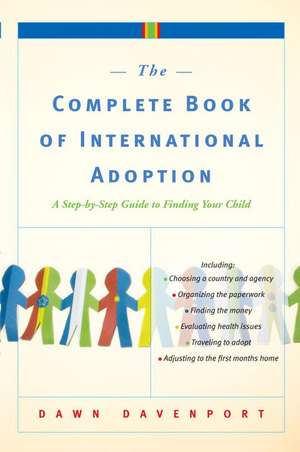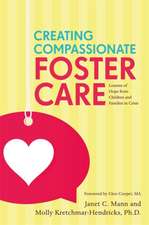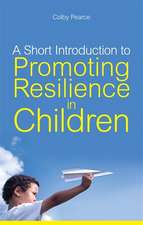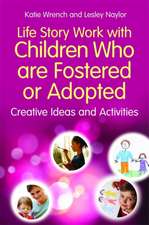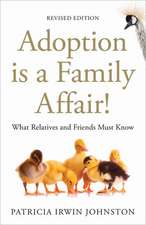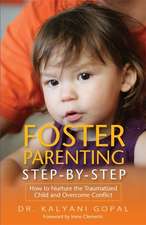The Complete Book of International Adoption: A Step by Step Guide to Finding Your Child
Autor Dawn Davenporten Limba Engleză Paperback – 31 oct 2006
From the initial decision—Is adoption right for you?—through returning home with your child—How can you ease the transition?—The Complete Book of International Adoption takes parents step by step through the entire process of adopting a child from another country.
You will find:
• An easy-to-understand analysis of the differences between domestic and international adoption
• Advice on choosing a country, including 25 important factors to consider, such as the waiting times involved and the estimated costs for each of the top placing countries, with charts for easy comparison
• A detailed discussion of the potential health issues based on the latest research and interviews with doctors who specialize in international adoption
• Worksheets and a suggested system for preparing and organizing the extensive paperwork involved
• Parenting tips to enhance attachment and suggestions for addressing the issues that come up in raising an internationally adopted child
• Real parents’ stories and advice at every stage of the process
• Plus all of the information you need to select your agency, plan financially, prepare for the home study, travel sensibly, evaluate your child’s health and integrate your new family
More than just provide the facts, The Complete Book of International Adoption also helps parents manage the emotional rollercoaster that comes with the territory. Sensitive, wise, and often witty, this book is a must-have for any parent considering building their family through adoption.
Preț: 122.23 lei
Nou
Puncte Express: 183
Preț estimativ în valută:
23.39€ • 24.42$ • 19.36£
23.39€ • 24.42$ • 19.36£
Carte disponibilă
Livrare economică 15-29 martie
Preluare comenzi: 021 569.72.76
Specificații
ISBN-13: 9780767925204
ISBN-10: 0767925203
Pagini: 395
Dimensiuni: 158 x 233 x 24 mm
Greutate: 0.46 kg
Editura: BROADWAY BOOKS
ISBN-10: 0767925203
Pagini: 395
Dimensiuni: 158 x 233 x 24 mm
Greutate: 0.46 kg
Editura: BROADWAY BOOKS
Notă biografică
Dawn Davenport is a mom of four through both birth and international adoption. She is a researcher, writer, attorney, and adoption expert. She can be reached through her website at www.findingyourchild.com. She speaks at many conferences on this topic and is interviewed frequently by national media. She lives in North Carolina.
Extras
Chapter 1
Is International Adoption Right for You?
Where DO Babies Come From?
After three doctors, two surgeries, and three failed in vitro fertilizations, Elizabeth and John were running short of time, money, and patience. John in particular was tired of the infertility merry-go-round and their life being defined by infertility. He felt their money and energy would be better spent on a surer bet. Elizabeth wasn’t ready to give up her dream. “The tension between us was building and I knew our relationship needed a break from infertility, but it was still something I had to process at my own speed,”
she recalls. After six more months of talking and continued treatments, Elizabeth began to get excited about the possibility of becoming a mom even if she couldn’t become pregnant. Elizabeth and John are now the proud parents of Emily and Lia, both adopted from China as babies. “I truly wonder now why we didn’t do this much sooner,” says Elizabeth. “I couldn’t possibly love them more or feel more like a mom if they had been born to me.”
People come to adoption from many different places. Single women adopt when they want to be a mom, but haven’t found the elusive Mr. Right and think a sperm bank is silly when kids are already out there who need a mom. A growing number of couples with one or two kids consider adoption because there are kids who need homes and they believe they could be just that home. Many people, however, turn to adoption because biology failed them. We are a “pull yourself up by the boots traps” nation; anything can be conquered with grit, determination, and money. Not so infertility. What was supposed to be as simple as buying a bottle of wine, lighting the candles, and ditching the condoms becomes a medical ordeal that sometimes no amount of money or perseverance can overcome.
Some couples caught up on the medical treadmill that is infertility are so focused on get ting a child that they jump immediately on to the adoption treadmill. It is important to slow down and give yourself time to grieve the losses of infertility before you assume that adoption is the right path to parenthood for you. Parenting through adoption is different from parenting through birth–not worse, not second best, just different. Your child, regardless of how she joins your family, deserves parents who want her for who she is, not because she is all they can get. Take the time to make sure you are that parent.
Is Adoption for You?
Answer the following questions honestly. No one is going to see your answers, so forget about political correctness and answer how you really feel.
1. Do you spend time imagining the child of your dreams–the perfect (or not so perfect) combination of you and your spouse’s genes?
___ Frequently ___ Sometimes ___ Seldom
2. Do you long to be pregnant or see your spouse pregnant?
___ Frequently ___ Sometimes ___ Seldom
3. Does it bother you that future generations of your family will not be related by blood to you and your ancestors?
___ Frequently ___ Sometimes ___ Seldom
4. Does it hurt you to see a pregnant woman or nursing mother?
___ Frequently ___ Sometimes ___ Seldom
5. Do you find it hard to talk about your infertility without crying or intense emotions, or do you avoid talking about your infertility at all?
___ Frequently ___ Sometimes ___ Seldom
6. Are you furious at God for afflicting you with infertility? (Why not boils or locusts, for goodness’ sakes!)
___ Frequently ___ Sometimes ___ Seldom
7. Do you feel like you are less of a woman or man because you can’t biologically have a child?
___ Frequently ___ Sometimes ___ Seldom
8. Do you feel pressured to hurry up and get past infertility and get on with adoption and the rest of your life?
___ Frequently ___ Sometimes ___ Seldom
9. Do you get angry at the thought of having to prove yourself worthy to adopt?
___ Frequently ___ Sometimes ___ Seldom
10. Do you wish you could skip all the adoption education and just jump straight to the part where a child is in your home?
___ Frequently ___ Sometimes ___ Seldom
Adoption professionals and psychologists strongly recommend that infertile couples resolve their infertility issues before they adopt. Coming to terms with infertility takes time. If you answered “frequently” to more than a few questions, you need more time to grieve.
Infertility robs you of m ore than just the opportunity to parent. It also takes away your dreams of pregnancy, your dreams of childbirth and breast - feeding, your dreams of biologically continuing your family line, and your dreams of your perfect child. In fertility also affects your sex life (privacy and spontaneity are the first victims) and your finances. I’ve included this litany of woes not to add fuel to your pity bon fire, but to help you see that adoption addresses only one of the many losses associated with infertility–the loss of raising a child.
Take the time you need. The decision to adopt, or not, is a process, not an event. Join Resolve, a national infertility support group. Read some of the infertility books and magazines listed in the Resource Guide at the end of this book, especially Adopting after Infertility by Patricia Irwin Johnston. Ask your local Resolve group or your infertility doctor for a referral to a therapist who is familiar with infertility.
Resolution does not necessarily mean that the grief entirely goes away, but it’s a matter of degrees. Many parents I interviewed said they knew they were ready to adopt when they wanted to parent more than they wanted to be pregnant. When you can answer sometimes and seldom to the adoption quiz questions, then it is time to go forward and find your child through adoption.
Adoption Facts vs. Myths
Adoption is often misunderstood, even though it has been around since the beginning of time. Even if you don’t believe these myths, others do, so it helps to address them at the beginning of your adoption journey.
Myth #1: Adopted kids grow up to have lots of problems.
Life experience should dispel this myth. Ask around and you’ll be surprised by the umber of well-adjusted people who have been adopted. Fortunately, we have more than just anecdotal reports; longitudinal studies have found that adoptees fare well in adolescence and adulthood (Bohman and Sigvardsson, 1990; Kelly et al., 1998).
Myth #2: You can’t really love an adopted child as much as you could love your
“own” child.
Oh yes you can! Love is not limited to biology. I love my husband more than life itself and he is not biologically related to me. Love for your children, by birth or adoption, grows from parenting, from nurturing, and from sharing your life. Your child is yours regardless of how he joined your family. Shortly after we adopted our daughter, a neighbor said to me that she couldn’t really love someone else’s child. Without realizing that she was inelegantly making a reference to our adoption, I replied wholeheartedly that I couldn’t either. All of my children are my own, and I love them each with a passion that sometimes scares me and often annoys them.
Myth #3: Your adopted child will never really consider you her real parents.
This is the flip side of myth #2. Real parents are the ones who stay up until the wee hours with a sick child and then a few years later are up in those same wee hours waiting for her to get home from a date. Real parents limit TV and candy and push educational games and vegetables. Real parents have gray hairs from worry and laugh lines from joy. Yes, adopted children have two sets of parents: one set who gave them life and one who raised them. But I know of no adopted child who considers their adoptive family any less than their real family, and this feeling is not lessened if they later decide to search for their birth family.
Myth #4: The kids adopted from _________ (choose one: Russia, China, Guatemala, Vietnam, India, etc.) have all kinds of problems.
There are no guarantees in parenting – or in life, for that matter. Birth children and adopted children can have health, learning, or behavioral issues. Possible problems are discussed at length in Chapters 2 and 8, but research over many years of adoption has shown that the vast majority of internationally adopted kids thrive. Early-life experiences do matter, but you can lower the risks of adopting a child with health or emotional problems by following the steps laid out in this book.
Myth #5: Adopting a child of another race or ethnicity is bound to cause problems
for the child.
International adoptions began with American families adopting Korean War orphans in the 1950s. More than fifty years of research on these transracial/transcultural adoptions, as well as research on African American children adopted by Caucasian parents, disproves this myth. Transracially adopted children usually adjust well, with strong racial identity, self–esteem, and attachment to their family. This does not mean that transracial adoption is for everyone or that transracial adoptees don’t have issues to face as they mature, but ultimately transracial adoptions can work. Refer to Chapters 2 and 10 for a
complete discussion on the issues to consider.
Myth #6: Adopted children should/will feel grateful to their adoptive parents.
Sorry to burst your bubble, but gratitude is not inherent in the nature of most children. I will get an occasional spontaneous “thank you,” a few more when demanded, and even more when they want something, but usually my children take what I offer as their due, which in fact, I suppose, it is. This is the case regardless of whether your kid becomes yours through birth or adoption. I am told that this changes once they are adults, but I’m still waiting. If you are adopting thinking of undying gratitude for rescuing a child, you likely won’t get it and no child deserves that pressure. You are adopting because you want to be a parent. It’s an added bonus that your child will get a home and a great family.
Myth #7: You are more likely to get pregnant after you adopt.
Adoptive children do not cast a fertility spell on their parents. If relaxation were all it took to get pregnant, you would have been pregnant the first six months you tried. The reason that you hear stories of Aunt Ida’s cousin’s hairdresser conceiving after adoption is that this is the exception that stands out because of its uniqueness. Do not adopt if your motivation is to increase your odds of getting pregnant. It won’t work and it is not fair to your child. Every child deserves to be the one you really want, not the one that keeps the dream of your perfect child alive.
International Adoption vs. Domestic Adoption
International and domestic adoption appeal to different people for different reasons. Neither is inherently better than the other, although one or the other may be better for you. I hate the competition that sometimes surfaces between proponents of either domestic or international adoption, with each side attempting to scare prospective families away from the other choice. Anytime a family finds a child and a child finds a family, regardless of whether that child is from Beijing or Boston, the world is a better place. I didn’t write this book to discourage families from considering domestic adoption. I wrote this book to help you decide between these options and, if international adoption is the right choice for you, to guide you in the process.
In my experience, most people will instinctively feel more comfortable with one type of adoption, depending on their priorities.
• The top priority for parents who are drawn to domestic private adoption is getting a child as young as possible with as much health information as possible.
• The top priority for parents who are drawn to the public foster-care system is providing a home for a child who really needs them.
• The top priorities for parents who are drawn to international adoption are the predictability of knowing that they will get a baby or toddler within a set period of time and a discomfort with the domestic adoption process (for example, the amount of time a birth parent has to revoke their consent to adopt or open adoption post-placement).
It helps to have a basic idea of how domestic and international adoptions differ. If you decide that domestic adoption is for you, look at the Resource Guide for suggestions on how to proceed.
Domestic Adoption
Domestic adoption covers both private adoptions (usually of infants) and public adoptions from the foster–care system (usually of older children).
Private domestic adoptions
Private domestic adoptions are about evenly divided between agency adoptions and independent adoptions, with the distinction being whether the birth parents place the infant with the adoptive parents through an adoption agency or independently (usually with the help of an attorney or facilitator). If you don’t work through an agency, you must hire an adoption attorney to handle the legal aspects of the adoption.Most private domestic adoptions are of newborns and gender selection is usually either prohibited or strongly discouraged. In almost all domestic adoptions, the birth parents (usually the birth mother) choose the adoptive parents based on pictures, biographical information, and meetings.
Adoption is governed by state law and a great deal of variation exists between the states, but in every state birth parents must either consent to the adoption through relinquishment of parental rights or have their parental rights terminated. In most private domestic adoptions, birth mothers relinquish their parental rights through consent. In most states, a parent must wait a set period of time after birth (ranging from one day to fifteen days) before they can consent to the adoption, and up until this time, they can change their mind. Estimates are that up to 50 percent of birth mothers who start the
adoption process change their mind during the process and decide to parent their child. They can change their mind before or after selecting an adoptive family, before or after their expenses are paid by the adoptive family, and before or after birth. The parental rights of unknown birth fathers present a special problem, and each state handles this situation differently. You should consult an experienced agency or attorney for advice.
Many states also give birth parents a set period of time after they have signed the relinquishment papers and placed the baby with the adoptive parents to change their mind (range is from 0 to 180 days). Although this is a nail-biting period for adoptive parents who are parenting the child during this time, it is required to make sure the birth parents are truly committed to the adoption. Once this legal time period has passed, it is extremely rare for a birth parent to successfully challenge the adoption. A good adoption attorney knows how to reduce this possibility. The media tend to focus on these cases
since they are unusual and sensational, just as they focus on the unusual and sensational plane crashes while ignoring the millions of safe landings. Crashes, whether of planes or adoptions, are always going to get more attention, but you shouldn’t make the decision to fly or adopt based on them.
Finding birth mothers who want to make an adoption plan for their child is key to private domestic adoptions, and there are many more families who want to adopt than birth mothers who want to place. How adoptive parents find birth mothers depends on the agency or attorney/facilitator. With some agencies, adoptive parents need only apply; the agency finds the birth mother and shows her biographical information on prospective adoptive families. She meets with several and then chooses one to parent her child. The waiting time to be selected varies greatly, depending on how flexible the adoptive parents are on health, race, and prenatal risks and how attractive their profile is to birth parents. Serendipity plays a role as well. To speed up the process, many facilitators and some agencies require adoptive parents to independently look for birth mothers. Print and Internet advertisements and toll-free telephone numbers are the norm. Usually independent adoptions with the proactive approach are faster and more expensive than agency adoptions, again depending on the flexibility of the adoptive parents.
Is International Adoption Right for You?
Where DO Babies Come From?
After three doctors, two surgeries, and three failed in vitro fertilizations, Elizabeth and John were running short of time, money, and patience. John in particular was tired of the infertility merry-go-round and their life being defined by infertility. He felt their money and energy would be better spent on a surer bet. Elizabeth wasn’t ready to give up her dream. “The tension between us was building and I knew our relationship needed a break from infertility, but it was still something I had to process at my own speed,”
she recalls. After six more months of talking and continued treatments, Elizabeth began to get excited about the possibility of becoming a mom even if she couldn’t become pregnant. Elizabeth and John are now the proud parents of Emily and Lia, both adopted from China as babies. “I truly wonder now why we didn’t do this much sooner,” says Elizabeth. “I couldn’t possibly love them more or feel more like a mom if they had been born to me.”
People come to adoption from many different places. Single women adopt when they want to be a mom, but haven’t found the elusive Mr. Right and think a sperm bank is silly when kids are already out there who need a mom. A growing number of couples with one or two kids consider adoption because there are kids who need homes and they believe they could be just that home. Many people, however, turn to adoption because biology failed them. We are a “pull yourself up by the boots traps” nation; anything can be conquered with grit, determination, and money. Not so infertility. What was supposed to be as simple as buying a bottle of wine, lighting the candles, and ditching the condoms becomes a medical ordeal that sometimes no amount of money or perseverance can overcome.
Some couples caught up on the medical treadmill that is infertility are so focused on get ting a child that they jump immediately on to the adoption treadmill. It is important to slow down and give yourself time to grieve the losses of infertility before you assume that adoption is the right path to parenthood for you. Parenting through adoption is different from parenting through birth–not worse, not second best, just different. Your child, regardless of how she joins your family, deserves parents who want her for who she is, not because she is all they can get. Take the time to make sure you are that parent.
Is Adoption for You?
Answer the following questions honestly. No one is going to see your answers, so forget about political correctness and answer how you really feel.
1. Do you spend time imagining the child of your dreams–the perfect (or not so perfect) combination of you and your spouse’s genes?
___ Frequently ___ Sometimes ___ Seldom
2. Do you long to be pregnant or see your spouse pregnant?
___ Frequently ___ Sometimes ___ Seldom
3. Does it bother you that future generations of your family will not be related by blood to you and your ancestors?
___ Frequently ___ Sometimes ___ Seldom
4. Does it hurt you to see a pregnant woman or nursing mother?
___ Frequently ___ Sometimes ___ Seldom
5. Do you find it hard to talk about your infertility without crying or intense emotions, or do you avoid talking about your infertility at all?
___ Frequently ___ Sometimes ___ Seldom
6. Are you furious at God for afflicting you with infertility? (Why not boils or locusts, for goodness’ sakes!)
___ Frequently ___ Sometimes ___ Seldom
7. Do you feel like you are less of a woman or man because you can’t biologically have a child?
___ Frequently ___ Sometimes ___ Seldom
8. Do you feel pressured to hurry up and get past infertility and get on with adoption and the rest of your life?
___ Frequently ___ Sometimes ___ Seldom
9. Do you get angry at the thought of having to prove yourself worthy to adopt?
___ Frequently ___ Sometimes ___ Seldom
10. Do you wish you could skip all the adoption education and just jump straight to the part where a child is in your home?
___ Frequently ___ Sometimes ___ Seldom
Adoption professionals and psychologists strongly recommend that infertile couples resolve their infertility issues before they adopt. Coming to terms with infertility takes time. If you answered “frequently” to more than a few questions, you need more time to grieve.
Infertility robs you of m ore than just the opportunity to parent. It also takes away your dreams of pregnancy, your dreams of childbirth and breast - feeding, your dreams of biologically continuing your family line, and your dreams of your perfect child. In fertility also affects your sex life (privacy and spontaneity are the first victims) and your finances. I’ve included this litany of woes not to add fuel to your pity bon fire, but to help you see that adoption addresses only one of the many losses associated with infertility–the loss of raising a child.
Take the time you need. The decision to adopt, or not, is a process, not an event. Join Resolve, a national infertility support group. Read some of the infertility books and magazines listed in the Resource Guide at the end of this book, especially Adopting after Infertility by Patricia Irwin Johnston. Ask your local Resolve group or your infertility doctor for a referral to a therapist who is familiar with infertility.
Resolution does not necessarily mean that the grief entirely goes away, but it’s a matter of degrees. Many parents I interviewed said they knew they were ready to adopt when they wanted to parent more than they wanted to be pregnant. When you can answer sometimes and seldom to the adoption quiz questions, then it is time to go forward and find your child through adoption.
Adoption Facts vs. Myths
Adoption is often misunderstood, even though it has been around since the beginning of time. Even if you don’t believe these myths, others do, so it helps to address them at the beginning of your adoption journey.
Myth #1: Adopted kids grow up to have lots of problems.
Life experience should dispel this myth. Ask around and you’ll be surprised by the umber of well-adjusted people who have been adopted. Fortunately, we have more than just anecdotal reports; longitudinal studies have found that adoptees fare well in adolescence and adulthood (Bohman and Sigvardsson, 1990; Kelly et al., 1998).
Myth #2: You can’t really love an adopted child as much as you could love your
“own” child.
Oh yes you can! Love is not limited to biology. I love my husband more than life itself and he is not biologically related to me. Love for your children, by birth or adoption, grows from parenting, from nurturing, and from sharing your life. Your child is yours regardless of how he joined your family. Shortly after we adopted our daughter, a neighbor said to me that she couldn’t really love someone else’s child. Without realizing that she was inelegantly making a reference to our adoption, I replied wholeheartedly that I couldn’t either. All of my children are my own, and I love them each with a passion that sometimes scares me and often annoys them.
Myth #3: Your adopted child will never really consider you her real parents.
This is the flip side of myth #2. Real parents are the ones who stay up until the wee hours with a sick child and then a few years later are up in those same wee hours waiting for her to get home from a date. Real parents limit TV and candy and push educational games and vegetables. Real parents have gray hairs from worry and laugh lines from joy. Yes, adopted children have two sets of parents: one set who gave them life and one who raised them. But I know of no adopted child who considers their adoptive family any less than their real family, and this feeling is not lessened if they later decide to search for their birth family.
Myth #4: The kids adopted from _________ (choose one: Russia, China, Guatemala, Vietnam, India, etc.) have all kinds of problems.
There are no guarantees in parenting – or in life, for that matter. Birth children and adopted children can have health, learning, or behavioral issues. Possible problems are discussed at length in Chapters 2 and 8, but research over many years of adoption has shown that the vast majority of internationally adopted kids thrive. Early-life experiences do matter, but you can lower the risks of adopting a child with health or emotional problems by following the steps laid out in this book.
Myth #5: Adopting a child of another race or ethnicity is bound to cause problems
for the child.
International adoptions began with American families adopting Korean War orphans in the 1950s. More than fifty years of research on these transracial/transcultural adoptions, as well as research on African American children adopted by Caucasian parents, disproves this myth. Transracially adopted children usually adjust well, with strong racial identity, self–esteem, and attachment to their family. This does not mean that transracial adoption is for everyone or that transracial adoptees don’t have issues to face as they mature, but ultimately transracial adoptions can work. Refer to Chapters 2 and 10 for a
complete discussion on the issues to consider.
Myth #6: Adopted children should/will feel grateful to their adoptive parents.
Sorry to burst your bubble, but gratitude is not inherent in the nature of most children. I will get an occasional spontaneous “thank you,” a few more when demanded, and even more when they want something, but usually my children take what I offer as their due, which in fact, I suppose, it is. This is the case regardless of whether your kid becomes yours through birth or adoption. I am told that this changes once they are adults, but I’m still waiting. If you are adopting thinking of undying gratitude for rescuing a child, you likely won’t get it and no child deserves that pressure. You are adopting because you want to be a parent. It’s an added bonus that your child will get a home and a great family.
Myth #7: You are more likely to get pregnant after you adopt.
Adoptive children do not cast a fertility spell on their parents. If relaxation were all it took to get pregnant, you would have been pregnant the first six months you tried. The reason that you hear stories of Aunt Ida’s cousin’s hairdresser conceiving after adoption is that this is the exception that stands out because of its uniqueness. Do not adopt if your motivation is to increase your odds of getting pregnant. It won’t work and it is not fair to your child. Every child deserves to be the one you really want, not the one that keeps the dream of your perfect child alive.
International Adoption vs. Domestic Adoption
International and domestic adoption appeal to different people for different reasons. Neither is inherently better than the other, although one or the other may be better for you. I hate the competition that sometimes surfaces between proponents of either domestic or international adoption, with each side attempting to scare prospective families away from the other choice. Anytime a family finds a child and a child finds a family, regardless of whether that child is from Beijing or Boston, the world is a better place. I didn’t write this book to discourage families from considering domestic adoption. I wrote this book to help you decide between these options and, if international adoption is the right choice for you, to guide you in the process.
In my experience, most people will instinctively feel more comfortable with one type of adoption, depending on their priorities.
• The top priority for parents who are drawn to domestic private adoption is getting a child as young as possible with as much health information as possible.
• The top priority for parents who are drawn to the public foster-care system is providing a home for a child who really needs them.
• The top priorities for parents who are drawn to international adoption are the predictability of knowing that they will get a baby or toddler within a set period of time and a discomfort with the domestic adoption process (for example, the amount of time a birth parent has to revoke their consent to adopt or open adoption post-placement).
It helps to have a basic idea of how domestic and international adoptions differ. If you decide that domestic adoption is for you, look at the Resource Guide for suggestions on how to proceed.
Domestic Adoption
Domestic adoption covers both private adoptions (usually of infants) and public adoptions from the foster–care system (usually of older children).
Private domestic adoptions
Private domestic adoptions are about evenly divided between agency adoptions and independent adoptions, with the distinction being whether the birth parents place the infant with the adoptive parents through an adoption agency or independently (usually with the help of an attorney or facilitator). If you don’t work through an agency, you must hire an adoption attorney to handle the legal aspects of the adoption.Most private domestic adoptions are of newborns and gender selection is usually either prohibited or strongly discouraged. In almost all domestic adoptions, the birth parents (usually the birth mother) choose the adoptive parents based on pictures, biographical information, and meetings.
Adoption is governed by state law and a great deal of variation exists between the states, but in every state birth parents must either consent to the adoption through relinquishment of parental rights or have their parental rights terminated. In most private domestic adoptions, birth mothers relinquish their parental rights through consent. In most states, a parent must wait a set period of time after birth (ranging from one day to fifteen days) before they can consent to the adoption, and up until this time, they can change their mind. Estimates are that up to 50 percent of birth mothers who start the
adoption process change their mind during the process and decide to parent their child. They can change their mind before or after selecting an adoptive family, before or after their expenses are paid by the adoptive family, and before or after birth. The parental rights of unknown birth fathers present a special problem, and each state handles this situation differently. You should consult an experienced agency or attorney for advice.
Many states also give birth parents a set period of time after they have signed the relinquishment papers and placed the baby with the adoptive parents to change their mind (range is from 0 to 180 days). Although this is a nail-biting period for adoptive parents who are parenting the child during this time, it is required to make sure the birth parents are truly committed to the adoption. Once this legal time period has passed, it is extremely rare for a birth parent to successfully challenge the adoption. A good adoption attorney knows how to reduce this possibility. The media tend to focus on these cases
since they are unusual and sensational, just as they focus on the unusual and sensational plane crashes while ignoring the millions of safe landings. Crashes, whether of planes or adoptions, are always going to get more attention, but you shouldn’t make the decision to fly or adopt based on them.
Finding birth mothers who want to make an adoption plan for their child is key to private domestic adoptions, and there are many more families who want to adopt than birth mothers who want to place. How adoptive parents find birth mothers depends on the agency or attorney/facilitator. With some agencies, adoptive parents need only apply; the agency finds the birth mother and shows her biographical information on prospective adoptive families. She meets with several and then chooses one to parent her child. The waiting time to be selected varies greatly, depending on how flexible the adoptive parents are on health, race, and prenatal risks and how attractive their profile is to birth parents. Serendipity plays a role as well. To speed up the process, many facilitators and some agencies require adoptive parents to independently look for birth mothers. Print and Internet advertisements and toll-free telephone numbers are the norm. Usually independent adoptions with the proactive approach are faster and more expensive than agency adoptions, again depending on the flexibility of the adoptive parents.
Descriere
This go-to guide offers everything would-be parents want to know about international adoption. More than just provide the facts, it also helps parents manage the emotional rollercoaster that comes with the territory. Sensitive, wise, and often witty, this book is a must-have for any parent considering building their family through adoption.
